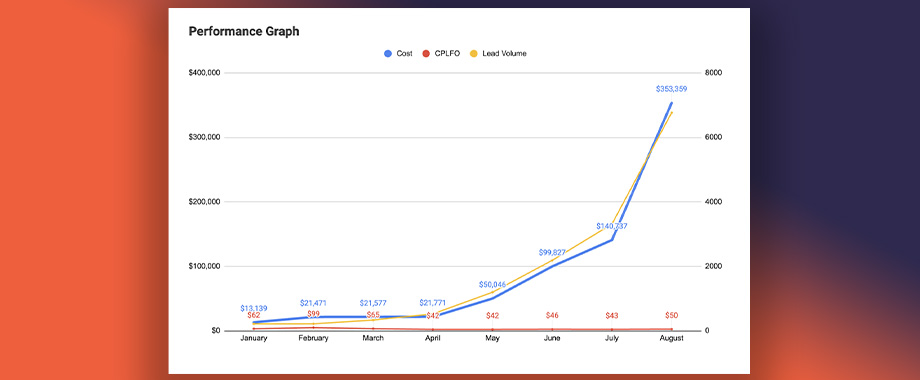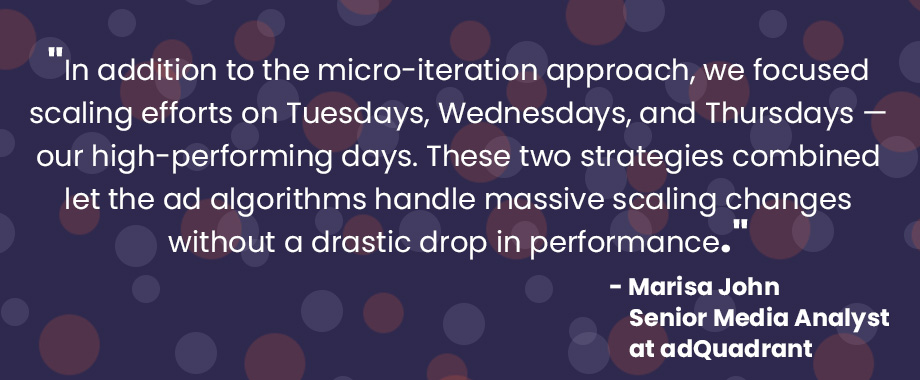Using Micro-Iterations to Identify Winning Creative and Support Scaling Initiatives
No marketer has a magic wand. But if they did, they’d probably want one that generated leads. At the very least, they’d want to know the budget they spent on ads had a measurable impact on those leads.
The closest thing we could find to that magic wand? A micro-iterative approach to your marketing creative. Micro-iterations can help you isolate which elements are making winning ads. From there, you can roll out the ads to a wide audience and quickly scale your business.
So why doesn’t everyone do it this way? It’s trickier than it sounds. And what are micro-iterations? How can you leverage them into something that resembles a magic wand? For us, it means going back to the observations made famous by a 19th-century Italian economist: the 80/20 rule.
The 80/20 Rule and Creative Micro-Iterations: How It Works
The 80/20 rule in economics refers to a simple principle. For any actions you take, about 20% of them are going to generate about 80% of the results. Vilfredo Pareto first observed this effect in landownership in 19th-century Italy. This distribution turned out to be so ubiquitous in business and economics, we in the 21st century just call it the “80/20 rule.”
What does that have to do with micro-iterations? Micro-iterations are simply a strategy of employing small, minuscule ad tests. When you have the results, you’ll know which 20% are generating 80% of the results.
Our strategy looks like this:
Introduce the Micro-Iterative Approach
We unleash a lot of variations of the same ad. This way, when we view the results, we can quickly isolate the key winners. And since the micro-iterative approach creates such specific results, it’s quicker to scale these winners in an ad campaign.
Optimize Towards the Lowest Front-End Cost
Think of the micro-iterative approach as a shortcut to larger sample sizes. Lowering the front-end cost of acquiring these leads gives us more room in the budget to go “wide” with our ad iterations later on. Voila—a bigger data set to work with, right off the bat.
Feeding Data to the Sales Team
After those steps, we have a large, lead-generation data set to feed the sales team. The more the sales team saw the results from our ads, the faster we learned where to “push the scale.” This strategy kept the ads profitable even as we scaled.
Here’s a look at it in action:

Having trouble spotting the differences? That’s the micro-iteration strategy at work.
The ads only had one small change at a time. $40,000 vs. $50,000, for example. Or maybe they featured identical copy with different photos.
To create micro-iterations, we first settled on our “anchor creatives.” Anchor creatives are the core messages that don’t change — for example, the phrase “Personal Loans” above, or the dollar amounts. Small tweaks were allowed, but the anchor creatives remained in place. This meant we could reduce decay and unlock the goal KPIs to drive our analytics.
In the example above, you’ll see we tested two variables: higher debt numbers and different photos. We wanted to see if these changes would generate higher customer values for our client.
And it worked. We quickly found that the algorithm favored versions 2 and 4. That meant “$50,000” was our winner, while the photos were less important. We now had a key insight that meant more leads and more profitability — as long as we scaled properly.
Using Micro-Iterations to Push Scale
Some of the scaling is built right in. After all, once you know which ad is working best, you can simply repeat it. We’ve iterated on this specific concept a total of five times. With each iteration, micro-iterations drive higher customer values while lowering the upfront costs.
We ran the initial version for five months, between April and September of 2022. But we’re still working with micro-iterations within the account to see which performs best, including:
- New photos
- Photos vs. animated photos
- “Rami” vs. “Ryan” photos — the two different photos you see above
At this point, you might wonder how one small change — like changing the dollar amount in the copy — can drive the kind of impact the 80/20 rule would suggest. But the 80/20 rule in advertising can be hard to see. Maybe you 10x the budget for a high-performing ad and watch as the larger sample size eats away at the results. This challenge is common in ad scaling.
But thanks to the micro-iteration strategy, we’re not seeing any decay in the average results. Even as we throw more budget behind the campaigns, the KPIs stay steady. Take a look at the performance graph of the ads:

As you can see, despite the significant scaling plan (overall costs were much higher), the CPL stayed within target range established early in the early months, as you can see above.
That’s the kind of scaling you want to see — as you put more money behind a campaign, the costs per lead generated remain stable. Without the micro-iteration strategy, you may see the CPL dip. That results in more money spent chasing the same leads.
The optimization work here isn’t done, either. Thanks to the micro-iteration strategy, we know our KPIs and we know what to optimize for. And we’ve set a goal CPL of $50–$60. If we do it right, we’ve increased efficiency even as the ads scale. Thank you, Vilfredo Pareto.
The Results of the Micro-Iteration Approach
A quick recap: in the above campaigns — January through August 2022 — we tested micro-iterations to maintain CPL while increasing the ad budget by 2,531%. And thanks to our rapid-testing of iterations (and commitment to killing the non-performers quickly), we consistently delivered an average debt load of about $20,000.
From the client’s perspective, this approach was a no-brainer. The client knew they were asking for a lot of scale in a hurry and they anticipated some volatility in the results they received. But with our strict “kill rules” for the micro-iterations that didn’t perform, there wasn’t as much volatility as one might expect.
In addition to the micro-iteration approach, we focused scaling efforts on Tuesdays, Wednesdays, and Thursdays — our high-performing days. These two strategies combined let the ad algorithms handle massive scaling changes without a drastic drop in performance.
In other words, putting the budget behind the ads that did perform was the quickest way to access the outcome promised by the 80/20 rule.

Moving Forward with 80/20
For upcoming campaigns, our plan is to scale the budget and test new initiatives with the same 80/20 approach. We’ll continue using similar micro-iterative creative tests on future platforms, then roll out limited budget scales to minimize dips in performance.
After all, it’s called the 80/20 rule for a reason. Manage your ads well, and it’s a principle that works.
About the author: Marisa is originally from the small town of Perris, California. She studied Cinema Television Arts at California State University, Fullerton but stumbled upon digital marketing her senior year of undergrad. Her love and passion for paid social media marketing was set in motion. She loves the science behind marrying data and creative to help drive the highest efficiency for her clients. In her free time, she enjoys all things movies, gaming and spending time with her cat Mittens.




